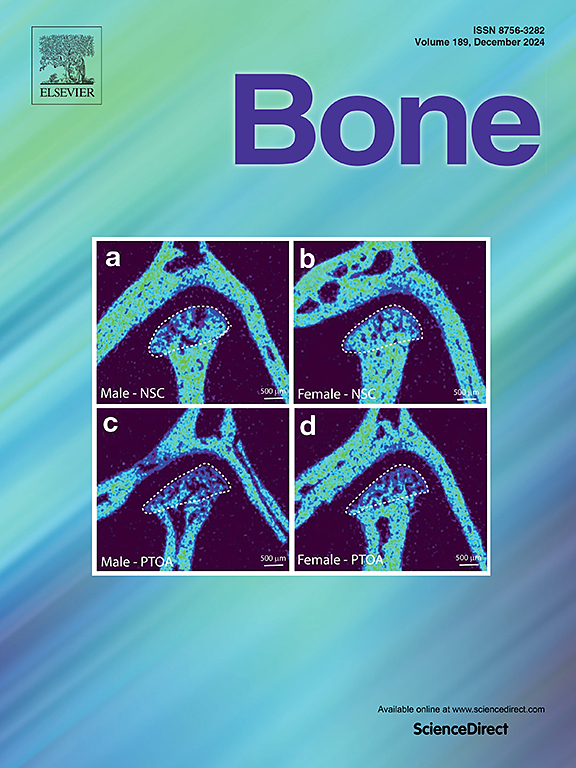评估骨小梁评分(TBS)在预测绝经后骨质疏松症患者脊椎骨折中的作用。
IF 3.5
2区 医学
Q2 ENDOCRINOLOGY & METABOLISM
引用次数: 0
摘要
本研究旨在评估骨小梁评分(TBS)在椎体骨折(VF)风险中的决定性作用,并确定绝经后骨质疏松症妇女的特定 TBS 临界值/s。我们对 107 名绝经后骨质疏松症妇女进行了研究,这些妇女的特征是 L1-L4 T 评分≤-3.0 且有 VF(第 1 组)和无 VF(第 2 组),或 L1-L4 T 评分≤-1.0 且≥-2.4 且有多处椎体骨折(VF)(第 3 组)。我们评估了 30 名 L1-L4 T 评分≤-1.0 和≥-2.4 且无 VF 的绝经后妇女作为对照组(第 4 组)。我们通过双 X 射线吸收仪(DXA)(QDR 4500;Hologic,马萨诸塞州沃尔瑟姆)测量 L1-L4、股骨颈和全髋骨矿物质密度(aBMD),并使用 TBS iNsight 软件(Medimaps,瑞士日内瓦)从去标识化的 DXA L1-L4 扫描中计算 TBS。通过胸椎和腰椎的前正位和左外侧标准化X光片对VF进行评估。我们计算了所有受试者的 FRAX® 值,以评估重大骨折和髋部骨折的 10 年骨折风险。42 名 L1-L4 T 评分≤-3.0 的受试者至少有一个 VF(第 1 组),41 名没有 VF(第 2 组)。24 名受试者的 L1-L4 T 评分≤-1.0 和≥-2.4,且至少有 3 个 VF(第 3 组)。我们观察到,与第 2 组相比,第 1 组和第 3 组的 TBS 值明显较低(p本文章由计算机程序翻译,如有差异,请以英文原文为准。
Assessment of trabecular bone score (TBS) in the prediction of vertebral fracture in postmenopausal osteoporosis
The study aimed to evaluate the role of trabecular bone score (TBS) as determinant in the risk for vertebral fracture (VF) and define specific TBS threshold/s in women with postmenopausal osteoporosis.
We studied 107 women with postmenopausal osteoporosis characterized by L1-L4 T-score ≤ −3.0 with (group 1) and without (group 2) VF, or L1-L4 T-score ≤ −1.0 and ≥ −2.4 and multiple vertebral fractures (VF) (group 3). We assessed 30 postmenopausal women with L1-L4 T-score ≤ −1.0 and ≥ −2.4 and no VF as controls (group 4). We measured L1-L4, femoral neck and total hip areal bone mineral density (aBMD) by dual X-ray absorptiometry (DXA) (QDR 4500; Hologic, Waltham, MA) and calculated TBS from de-identified DXA L1-L4 scans by the TBS iNsight software (Medimaps, Geneva, Switzerland). The assessment of VF was performed by means of anteroposterior and left lateral standardized radiographs of the thoracic and lumbar spine. We calculated the FRAX® value in all subjects for the assessment of 10-year fracture risk for major and hip fractures.
Forty-two subjects with L1-L4 T-score ≤ −3.0 had at least one VF (group 1), while 41 have no VF (group 2). Twenty-four subjects had L1-L4 T-score ≤ −1.0 and ≥ −2.4 and at least 3 VF (group 3). We observed significantly lower TBS values in group 1 and group 3 compared to group 2 (p < 0.001) and group 4 (p < 0.05). L1-L4 aBMD and TBS values were not significantly associated in all groups. Interestingly, TBS values were independently associated with the presence of VF (log odds ratio − 8, p < 0.001) but not with the number of VF by the stepwise regression analysis. Furthermore, when we applied the cut-off value of TBS associated with degraded microarchitecture and elevated fracture risk (< 1.23), only 52 % of the subjects had VF. The cut-off value of TBS below which VF could be predicted was calculated by the receiver operating characteristic curve analysis and was 1.13.
Our study demonstrates an independent association between altered trabecular microarchitecture, assessed by TBS, and the occurrence of VF in postmenopausal women with osteoporosis. This association is significant for values of TBS lower than those reported by population-based studies. Cut-off values of TBS need further evaluation by specifically designed studies assessing disease- specific thresholds for fracture risk.
求助全文
通过发布文献求助,成功后即可免费获取论文全文。
去求助
来源期刊

Bone
医学-内分泌学与代谢
CiteScore
8.90
自引率
4.90%
发文量
264
审稿时长
30 days
期刊介绍:
BONE is an interdisciplinary forum for the rapid publication of original articles and reviews on basic, translational, and clinical aspects of bone and mineral metabolism. The Journal also encourages submissions related to interactions of bone with other organ systems, including cartilage, endocrine, muscle, fat, neural, vascular, gastrointestinal, hematopoietic, and immune systems. Particular attention is placed on the application of experimental studies to clinical practice.
 求助内容:
求助内容: 应助结果提醒方式:
应助结果提醒方式:


